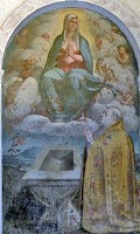Bishop Costantino Eroli planned the construction of two chapels at the beginning of the right aisle:
-
✴the Cappella di San Leonardo, which opens on to the 1st bay of the aisle; and
-
✴the adjoining Cappella dell’ Assunta, which opens into the loggia in front of the Duomo (see the page on the Exterior).
The original documentation for the construction of the chapels does not survive, but an inscription in the marble frieze in the Cappella di San Leonardo (which was the first to be finished) gives the date of its completion as 1497.
Cappella di San Leonardo
The design of this narrow chapel and is usually attributed to Ambrogio Barocci. He might also have designed and carved:
-
✴the aedicule on the altar wall (illustrated below); and
-
✴the frieze that runs around the chapel, which was originally gilded against a blue background.
The chapel has been seriously undermined by problems of humidity over the centuries. It has also suffered major modifications:
-
✴A second window was inserted [when ?] to the left of the original window in the left wall.
-
✴Its façade was moved back by about 30 cm during the re-modeling in 1785, and this caused the loss of the original portal and damage to the frieze.
-
✴The door in the right wall that leads to the Cappella dell’ Assunta was replaced and moved to the right in 1932. The triangular relief of angels carrying the Eroli arms probably belonged to the original portal in the counter-facade of the chapel.
Frescoes (ca. 1497)
The attribution of the frescoes in the chapel to Pintoricchio was first made in 1848, but it is now generally accepted. (The frieze described above might have been inspired by that designed by Pintoricchio in ca. 1492 for the Borgia apartments in the Vatican).
God the Father
This fresco is in the lunette above the altar. God is seated on clouds within a mandorla. Two angels (one badly damaged) kneel to the sides.
Madonna and Child with saints
This fresco occupies the curved wall of the apse and acts as an altarpiece. The Madonna and Child are enthroned between two trees (a palm tree and a locust tree) with SS John the Baptist and Leonard to the sides. The scene is set outside the walls of a city by a lake. Outside one of the city gates, to the right of the Madonna and Child, a Dominican preaches to a large crowd.
The fresco was restored in 1932 in an effort to repair the damage caused by the humid conditions in the chapel. Unfortunately, the cloak of the Madonna and that of St John the Baptist, which had been applied “al secco”, were beyond repair.
Pietà
This damaged fresco acts as a fictive frontal to the altar.
Frescoes on the Ceiling
There were originally nine monochrome frescoes on the ceiling:
-
✴a central tondo with the Eroli arms;
-
✴a sibyl at each corner; and
-
✴scenes from the life of the Emperor Constantine between them.
Only one sibyl and one scene from the life of the Emperor Constantine survive.
Funerary Chapel
The space between the two chapels was used for the funerary monument of Bishop Costantino Eroli (died 1500) and Bishop Francesco Eroli (died 1540). These monuments seem to have been removed in the 16th century. The remains of one of the bishops, which were retrieved in 1932, were interred in a niche in the wall.
The lunettes on the back wall of this chapel contain a frescoed cityscape of Narni (the native city of the Eroli family), in which the the Rocca and Ponte di Augusto are visible.
Cappella dell' Assunta
This larger chapel extends into the space to the right of the portico in front of the facade. It is formally dedicated to the Virgin and St John the Baptist. Bishop Francesco Eroli, who succeeded his uncle in 1500, commissioned its decoration. Two chaplains were appointed in 1535 but the altar had still not been consecrated in 1563, some 23 years after the death of Francesco Eroli.
Assumption of the Virgin (ca. 1535)
The panel in an aedicule on the altar wall is attributed to Jacopo Siculo. It depicts the Virgin seated on clouds while Bishop Francesco Eroli prays before the empty tomb below.
Frescoes on the walls (ca. 1535)
These frescoes, which are also attributed to Jacopo Siculo, depict:
-
✴on the altar wall:
-
•the Crucifixion with angels; and
-
•St John the Baptist and the Apostles, who witness the Assumption of the Virgin.
-
-
•Aaron in front of the Temple (in the lunette); and
-
•St Jerome in the desert (illustrated here).
-
-
•Elisha raised to Heaven in a chariot (in the lunette - illustrated here); and
-
•the vocation of St Peter.
-
-
•scenes from the life of Elisha (in the lunette);
-
•St Michael (illustrated here); and
-
•St Lucy.
The frieze around the walls contains three portraits that probably depict the three Eroli bishops.
Frescoes in the vaults (ca. 1535)
These frescoes, which depict figures from the Old Testament (Adam, Noah, Moses and Melchizedec), seem to be by an artist who was influenced by the work of the followers of Raphael in Rome in the 1520s, and who probably also painted the broadly contemporary frescoes on the facade of Palazzo Racani. He has been identified alternatively as:
-
✴Giovanni da Spoleto, who is known only from his signature (along with that of Vincenzo Tamagni) on the frescoes (1516) in the apse of Santa Maria di Arrone (by Giovanna Sapori, referenced below); or
-
✴Tommaso Bernabei, il Papacello (by Mario Gori Sassoli, also referenced below).























